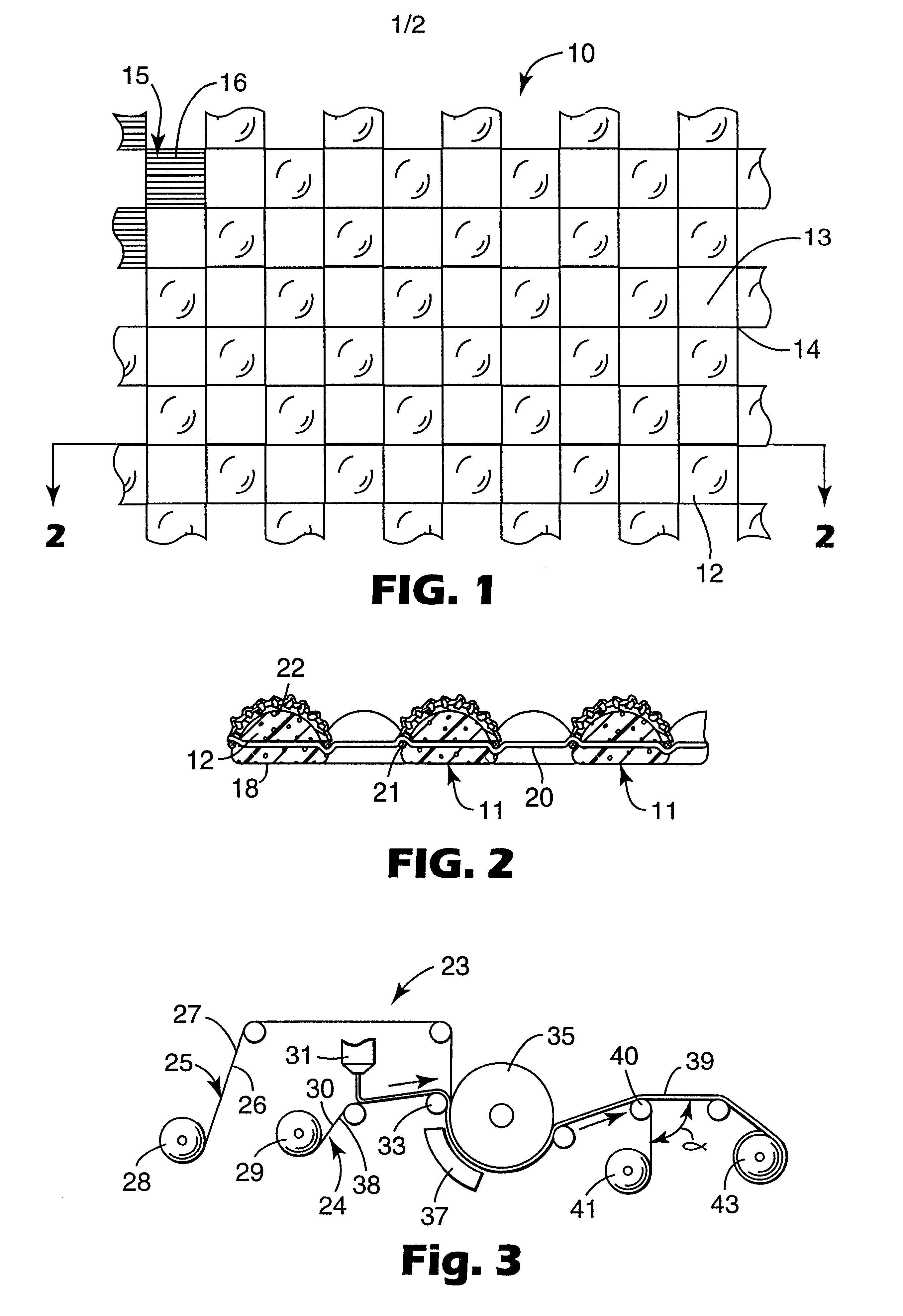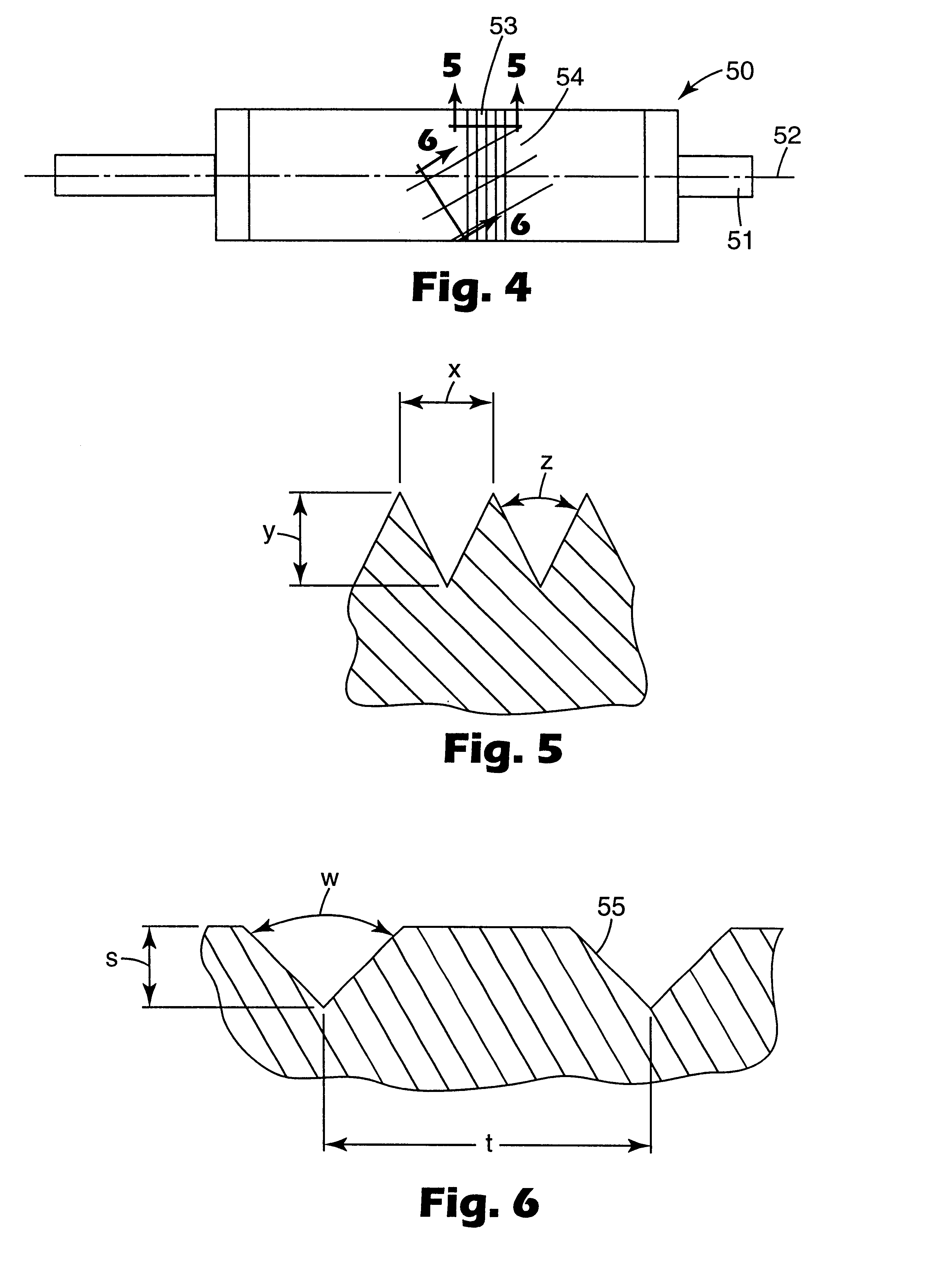Abrasive product and method of making the same
a technology of abrasives and products, applied in the direction of grinding devices, manufacturing tools, other chemical processes, etc., can solve the problem of not being the cas
- Summary
- Abstract
- Description
- Claims
- Application Information
AI Technical Summary
Benefits of technology
Problems solved by technology
Method used
Image
Examples
example 1
A water borne acrylic make coat adhesive precursor, "Formulation M-1," was made by mixing; 90.1% HYCAR 2679, 8.0% Water, 0.09% EZ-3 solution, 0.09% Ammonium Hydroxide solution, 0.22% SILWET L-77 and 1.5% maroon pigment from Sun Chemicals in a suitable size baffled vessel with a high shear mixer. The water served as a diluent. The resulting mixture had a viscosity of 2300 cps (BROOKFIELD Model DV-I viscometer, spindle No. 3, rotated at 20 RPM at 20.degree. C.) and percent solids of 45%.
A 30 cm by 30 cm square of flexible Substrate A was weighed to determine its basis weight for further processing. Substrate A was a 3 mm thick open mesh, resilient, non-slip matting made from scrim reinforced polyvinyl chloride foam. Substrate A was identified under the trade designation Black Polyester-PVC Perforated Foam, available from McMaster-Carr as catalog #85695K31. The individual resilient bodies were approximately 4 mm wide and 4.6 mm long. Each body had a slightly hemispherical domed upper s...
example 2
A 30 cm by 30 cm square of flexible sheet substrate B was weighed to establish its basis weight for further testing. Substrate B was a 5 mm thick open mesh, resilient, non-slip matting made from scrim reinforced poly vinyl chloride foam. The individual "resilient bodies" were approximately 9 mm wide and 9 mm long. Each body had a slightly hemispherical domed shape. Approximately 57% of the surface area was composed of solid material with the remaining 43% being void space. Products similar to this were manufactured by MSM Industries, Smyrna, Tenn.
A water borne make coat adhesive precursor, "Formulation M-1," was made as in Example 1. The make coat precursor was spray coated over the first surface of substrate B. Spray coating was by using a hand held conventional high-pressure paint spray gun manufactured by Campbell Hausfeld. The sample had a dry add-on weight of 190 g.m.sup.2.
ALODUR FRPL grade 60 mineral abrasive particles were then evenly applied to the wet surface with a sandbla...
example 3
A cycloaliphatic epoxy and polyol mixture make coat adhesive precursor, "Formulation M-2," was made by mixing; 58.8% ERL4299, 39.2% SYNFAC 8009, 2.0% SD1010 in a suitable size baffled vessel with a high shear mixer. The resulting mixture had a viscosity of 2500 cps (BROOKFIELD Model DV-I viscometer, spindle No. 3, rotated at 20 RPM at 20.degree. C.) and percent solids of 100%.
A 15 cm.times.60 cm flexible sample of Substrate A was weighed to determine its basis weight for further processing.
The make coat precursor was applied using a small two roll roll-coater to the flexible-sheet like substrate A. This roll-coater was a standard two-roll type equipped with a 15 cm (6-inch) diameter rubber covered bottom roll and a 7.6 cm (3-inch) diameter polished steel top roller. The bottom roller was fitted with a doctor blade for adhesive metering purposes. Sample was weighed to determine the dry add-on weight which was 132 g / m.sup.2.
Aluminum Oxide grade 120 mineral abrasive particles were then...
PUM
| Property | Measurement | Unit |
|---|---|---|
| thickness | aaaaa | aaaaa |
| size | aaaaa | aaaaa |
| thick | aaaaa | aaaaa |
Abstract
Description
Claims
Application Information
 Login to View More
Login to View More - R&D
- Intellectual Property
- Life Sciences
- Materials
- Tech Scout
- Unparalleled Data Quality
- Higher Quality Content
- 60% Fewer Hallucinations
Browse by: Latest US Patents, China's latest patents, Technical Efficacy Thesaurus, Application Domain, Technology Topic, Popular Technical Reports.
© 2025 PatSnap. All rights reserved.Legal|Privacy policy|Modern Slavery Act Transparency Statement|Sitemap|About US| Contact US: help@patsnap.com


